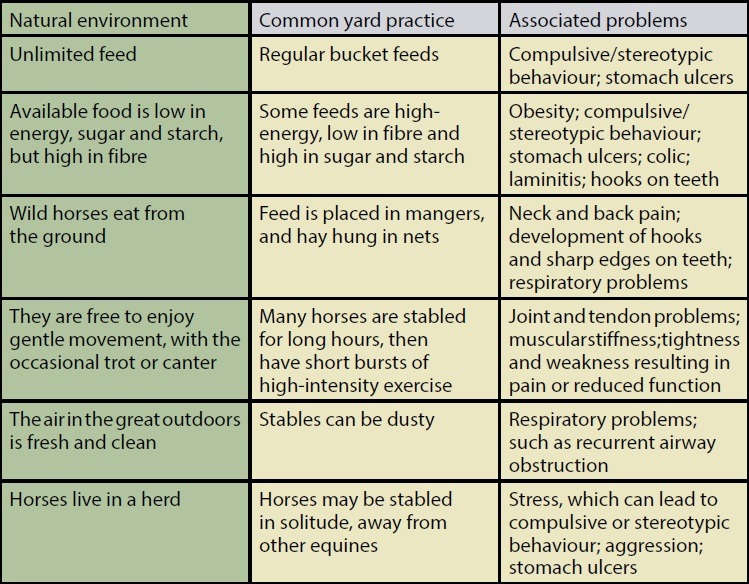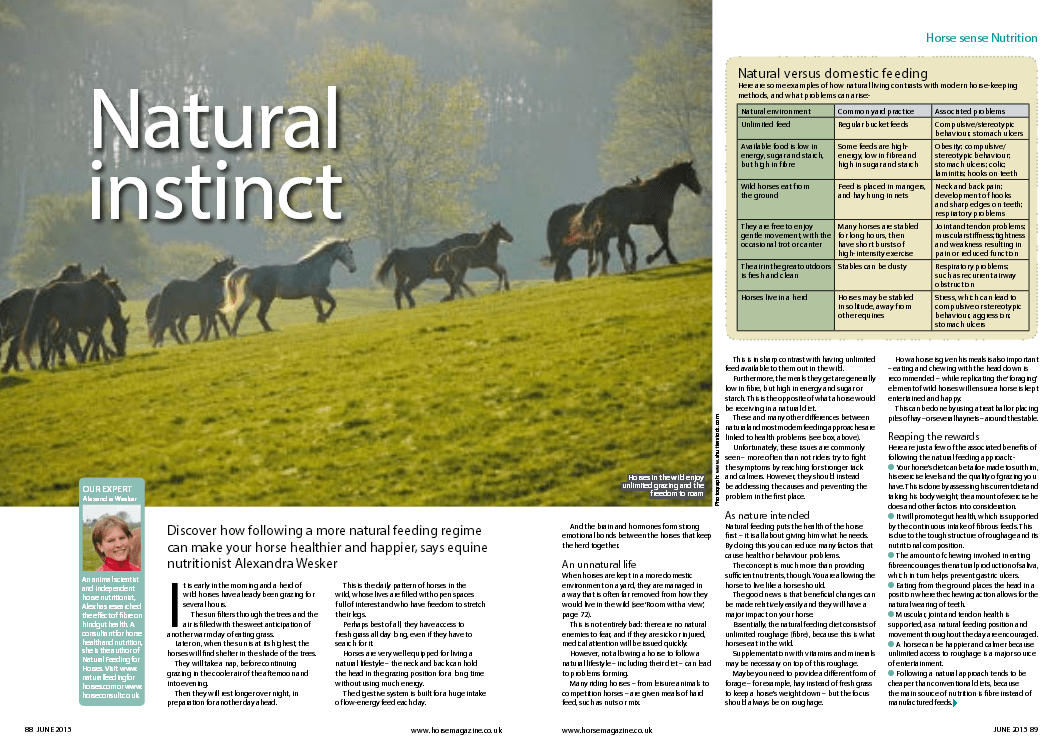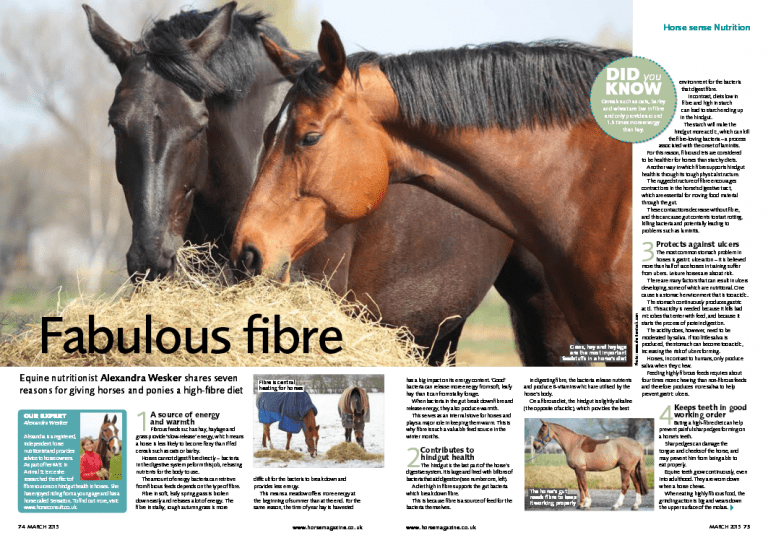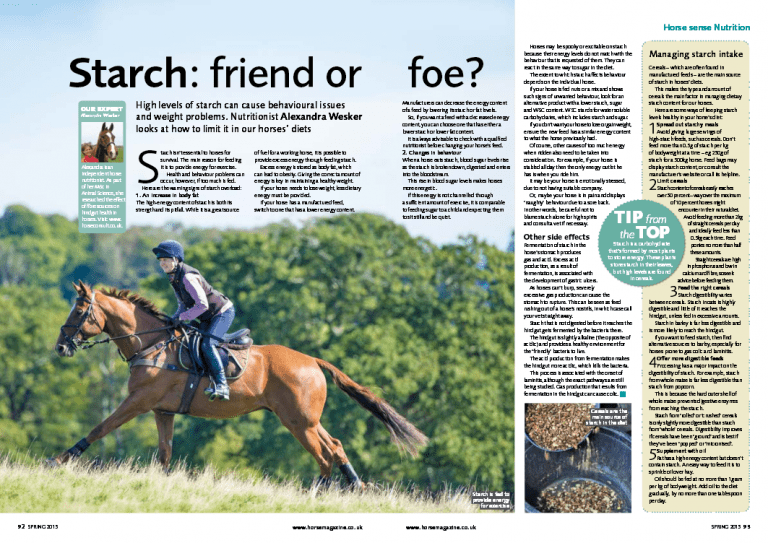Natural instinct
As published in Horse Magazine
Our expert Alexandra Wesker: An animal scientist and independent horse nutritionist, Alex has researched the effect of fibre on hindgut health. A consultant for horse health and nutrition, she is the author of Natural Feeding for Horses. Visit: www.naturalfeedingforhorses.com or www.horseconsult.co.uk.
Discover how following a more natural feeding regime can make your horse healthier and happier, says equine nutritionist Alexandra Wesker
It is early in the morning and a herd of wild horses have already been grazing for several hours. The sun filters through the trees and the air is filled with the sweet anticipation of another warm day of eating grass. Later on, when the sun is at its highest, the horses will find shelter in the shade of the trees.
They will take a nap, before continuing grazing in the cooler air of the afternoon and into evening.
Then they will rest longer over night, in preparation for another day ahead.
This is the daily pattern of horses in the wild, whose lives are filled with open spaces full of interest and who have freedom to stretch their legs.
Perhaps best of all, they have access to fresh grass all day long, even if they have to search for it.
Horses are very well equipped for living a natural lifestyle – the neck and back can hold the head in the grazing position for a long time without using much energy.
The digestive system is built for a huge intake of low-energy feed each day.
And the brain and hormones form strong emotional bonds between the horses that keep the herd together.
An unnatural life
When horses are kept in a more domestic environment on a yard, they are managed in a way that is often far removed from how they would live in the wild.
This is not entirely bad: there are no natural enemies to fear, and if they are sick or injured, medical attention will be issued quickly.
However, not allowing a horse to follow a natural lifestyle – including their diet – can lead to problems forming.
Many riding horses – from leisure animals to competition horses – are given meals of hard feed, such as nuts or mix.
This is in sharp contrast with having unlimited feed available to them out in the wild.
Furthermore, the meals they get are generally low in fibre, but high in energy and sugar or starch. This is the opposite of what a horse would be receiving in a natural diet.
These and many other differences between natural and most modern feeding approaches are linked to health problems (see box, below).
Unfortunately, these issues are commonly seen – more often than not riders try to fight the symptoms by reaching for stronger tack and calmers. However, they should instead be addressing the causes and preventing the problem in the first place.
Natural versus domestic feeding
Here are some examples of how natural living contrasts with modern horse-keeping methods, and what problems can arise:

As nature intended
Natural feeding puts the health of the horse first – it is all about giving him what he needs. By doing this you can reduce many factors that cause health or behaviour problems.
The concept is much more than providing sufficient nutrients, though. You are allowing the horse to live like a horse should.
The good news is that beneficial changes can be made relatively easily and they will have a major impact on your horse.
Essentially, the natural feeding diet consists of unlimited roughage (fibre), because this is what horses eat in the wild.
Supplementation with vitamins and minerals may be necessary on top of this roughage.
Maybe you need to provide a different form of forage – for example, hay instead of fresh grass to keep a horse’s weight down – but the focus should always be on roughage.
How a horse is given his meals is also important – eating and chewing with the head down is recommended – while replicating the ‘foraging’ element of wild horses will ensure a horse is kept entertained and happy.
This can be done by using a treat ball or placing piles of hay – or several haynets – around the stable.
Reaping the rewards
Here are just a few of the associated benefits of following the natural feeding approach:
Your horse’s diet can be tailor-made to suit him, his exercise levels and the quality of grazing you have. This is done by assessing his current diet and taking his body weight, the amount of exercise he does and other factors into consideration.
It will promote gut health, which is supported by the continuous intake of fibrous feeds. This is due to the tough structure of roughage and its nutritional composition.
The amount of chewing involved in eating fibre encourages the natural production of saliva, which in turn helps prevent gastric ulcers.
Eating from the ground places the head in a position where the chewing action allows for the natural wearing of teeth.
Muscular, joint and tendon health is supported, as a natural feeding position and movement throughout the day are encouraged.
A horse can be happier and calmer because unlimited access to roughage is a major source of entertainment.
Following a natural approach tends to be cheaper than conventional diets, because the main source of nutrition is fibre instead of manufactured feeds.
5 ways to offer a natural diet
1. Feed unlimited fibre
A fibre-based diet can improve gut health and will keep horses entertained for longer.
If grass, hay or haylage intake is restricted, horses have to fill the time with another activity – this may result in compulsive or stereotypic behaviours, such as cribbing and weaving.
Fibre should form the main source of nutrients for horses and the correct type should be fed in unlimited amounts. Feeding bucket meals with periods of not eating should be avoided.
The nutritional composition of fibre varies greatly, which means it can be too rich or poor for an individual horse.
Natural feeding addresses this by scoring a horse’s energy requirements and comparing it to the nutritional value of your grass/hay. This indicates whether extra vitamins and minerals are required, or if you need to switch to less-rich grass/hay/haylage.
2. Place feed on the ground
In nature, horses feed with their head down, which does not use much energy.
Feeding away from the ground, such as in a haynet tied to the wall, requires the horse to lift his head. This uses neck and back muscles that are not designed to work for long periods of time, and can result in pain that may be noticed as a loss of performance under saddle.
Also, dust from strung-up hay can more easily be inhaled, increasing the chances of respiratory problems.
Placing food on the ground encourages a correct chewing motion, while feeding away from the ground causes teeth to wear down incorrectly.
3. Make dietary changes gradually
The natural diets of horses do not change overnight. Bacterial colonies in the gut can be easily upset by sudden changes, potentially causing colic or laminitis.
The amount of concentrates should be changed no faster than by 0.5kg (1lbs) a day and oil supplementation by no more than one tablespoon a day.
Hay from different harvests should be mixed when transitioning from one bale to the next. In the same way, the change from hay to pasture and vice versa should be made gradually, for example by restricting pasture access initially and supplying hay.
4. Analyse your forage
People often focus more on which concentrates to feed instead of assessing roughage quality. This is like an athlete being more concerned with energy bars than with the bulk of their diet.
Have your roughage analysed – some feed companies offer this service. (They can provide guidelines on how to take and send samples of your roughage.) Choose any supplemental feeds based on your forage composition, with the aid of a qualified equine nutritionist.
5. Offer small meals
‘Meals’ refer to anything other than fibre sources – so, horse and pony nuts or mixes. It has been proven that feeding large meals can cause digestive upsets, especially with high starch feed.
Never feed meals of over 1.5kg (3lb), or meals of straight cereals over 0.5kg (1lb). ponies should be fed no more than half these amounts.
Spread meals over small portions throughout the day. To allow foraging behaviour, consider offering some of his feed using a treat ball.
Natural approach
Natural Feeding For Horses, by Alexandra Wesker, is priced £24.99 and is available from Amazon.




